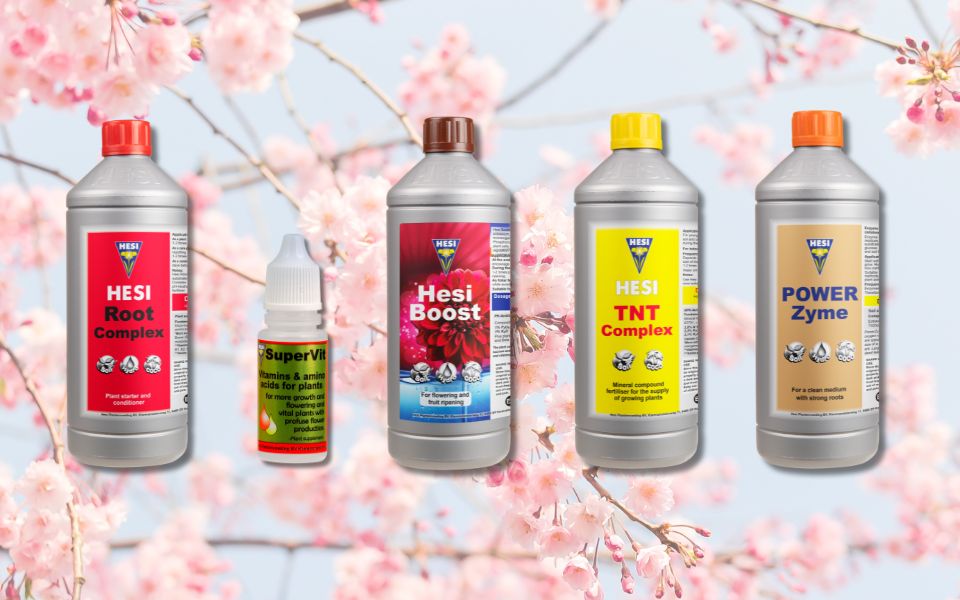Prepping Your Plants for Spring
Spring is just around the corner, and it's the perfect time to get your green friends ready for a season of vibrant growth and blooming beauty. Whether you're a seasoned gardener or just starting to dip your toes into the soil, these tips will help you and your plants spring into action. So, grab your gardening gloves, and let's get started!
Wake up your indoor plants
As the days grow longer, your indoor plants will start to notice and awaken from their slumber. Here's how to help them adjust and thrive.
As plants wake up from their winter rest, they'll need more water. Start increasing watering frequency, but be mindful not to overdo it. A simple yet effective way to check if your plants need water is by sticking your finger into the soil. If it feels dry about 2.5 cm (1 inch) below the surface, it's a good sign that your plant is ready for a drink. This method helps prevent overwatering, ensuring that your plants receive just the right amount of moisture to support their spring growth.
Next, pruning plays a pivotal role in waking up your plants. By trimming away any dead or yellowing leaves, you're not only tidying up your plant but also redirecting its energy towards sprouting new growth. Spring is the perfect time to also cut back any overgrown parts of your plant. This not only helps maintain its shape but encourages a bushier, more robust growth.
Lastly, light is a crucial element that signals to your plants that it's time to grow. Move plants closer to windows or into brighter spots to take advantage of the increasing daylight. Just be mindful of direct sunlight which can be too intense for some plants.
Prep your garden
Your outdoor garden needs some love too. Starting with a thorough clean-up is fundamental. Clear away any debris, dead foliage, and weeds. This not only tidies up your space but also reduces the risk of pests and diseases.
Next, conducting a soil check is crucial. Testing your garden's soil for its pH and nutrient levels provides invaluable insights into its condition. This can guide you on what amendments you may need to add to ensure your soil is in prime condition. Based on your soil test, incorporate compost or other organic matter to improve soil structure and nutrient content. If your soil is too acidic or alkaline, you can adjust it using lime (to decrease acidity) or sulfur (to increase acidity). Read for more information our blog ‘5 Things You Need to Know about Soil’.
Lastly, planning your planting is an exciting phase where you get to envision the future of your garden. Sketch out a plan for what you’d like to plant and where. Consider plant companions that thrive together and how much sun each area gets.
Give your plants a boost
Kick-off your fertiliser routine to support new growth in your plants. Incorporating our specialized products can significantly enhance your plants' growth and health. Here's a quick rundown of how each product can boost your plants this spring:
- HESI Root Complex: Kickstarts your plants' season by stimulating robust root growth. Healthier roots mean a stronger foundation for overall plant development.
- HESI SuperVit: Acts as a multi-vitamin for your plants, supplying essential vitamins and amino acids that promote vigorous growth and vitality of both roots and foliage.
- HESI Boost: A flowering phase stimulator that encourages dense, lush blooms. It's perfect for giving your plants that extra push to produce vibrant flowers.
- HESI TNT Complex: A nitrogen-rich fertiliser that supports vigorous vegetative growth without the risk of over-fertilization, making it ideal for green plants waking up from their winter rest.
- HESI PowerZyme: Enhances root activity and improves soil health by breaking down dead plant material, which in turn makes nutrients more accessible to your plants.

Transitioning plants outdoors
If you have plants that you've overwintered indoors or plan to start seeds outside, they'll need to be acclimated to outdoor conditions. The process begins with hardening off your plants. This involves gradually introducing them to the outdoor environment to avoid the shock that can occur from sudden exposure to direct sunlight, wind, and cooler temperatures. Start with an hour a day in a sheltered location and increase the time over a week or two.
Timing is everything when it comes to moving your plants outdoors. Wait until the risk of frost has passed before planting sensitive plants outside. Check local frost dates to be safe. These dates are a guideline for when it's typically safe to plant outside without the threat of frost damaging your plants. Protecting your young plants is also paramount as they acclimate to their new environment. Use cloches or row covers to protect young plants from cool nights and pests.
Pest and weed prevention
A little prevention goes a long way. By taking a few proactive steps, you can create an environment that supports your plants' well-being while deterring common garden nuisances.
Starting with mulch, this simple yet effective strategy does wonders for your garden. Applying a generous layer of mulch around your plants not only helps in suppressing weed growth, which competes with your plants for nutrients and water, but it also plays a crucial role in moisture retention. This is particularly beneficial during those warmer days when the soil tends to dry out quickly. Additionally, mulch helps in regulating soil temperature, keeping it consistently cool and conducive for plant growth.
.jpg)
Introducing natural deterrents into your garden ecosystem can also significantly reduce the need for chemical interventions. Beneficial insects, such as ladybugs, are natural predators of common pests like aphids and can help keep their populations in check. Similarly, planting marigolds and other plant companions that naturally repel pests not only adds beauty to your garden but also serves as a protective barrier against unwanted invaders. These natural deterrents work in harmony with your garden, promoting a balanced ecosystem where your plants can thrive.
Keep an eye on your plants for signs of pests or disease. Early detection is key to managing outbreaks. Regular inspections give you a firsthand look at your garden's health, enabling you to act swiftly and effectively at the first sign of trouble. This proactive approach not only saves you time and resources in the long run but also ensures your garden remains a vibrant and healthy environment.
Spring is a time of renewal and growth, not just for nature but for gardeners too. By following these tips, you'll set the stage for lush, thriving plants that will bring joy all season long. So, let's celebrate the warmer weather and longer days by giving our plants the care and attention they deserve. Happy gardening!
- Cultivation Tips : Plant Care
- Nature: Climate Stories
- Growth period: Grow , Bloom
 Deutsch
Deutsch  Français
Français  Español
Español 

.jpg)